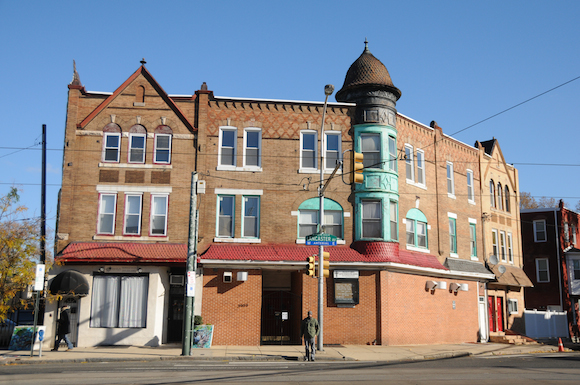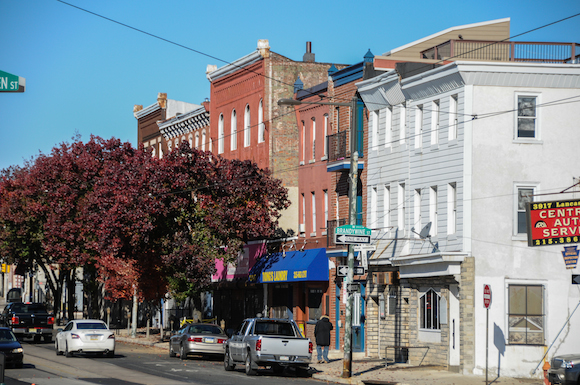We Are Mantua
In the 1980s, they were Enterprise Zones. In the 1990s and 2000s, they were Empowerment Zones and Renewal Communities. Today, President Obama calls them Promise Zones — federally funded, place-based development efforts hoping to spark community revitalization through a combination of public programs and private investment.
West Philadelphia is one of the first five Promise Zones in the country.
The designation became official in January, on the anniversary of the announcement of Lyndon B. Johnson’s War on Poverty. The Promise Zone will receive technical assistance and preferential treatment for federal grant applications and may benefit from tax assistance requested by President Obama. San Antonio, Los Angeles, southeastern Kentucky and the Choctaw Nation in Oklahoma are home to the other four zones; about 15 more are expected to be announced over the next three years.
Lancaster Avenue in Mantua

Years of community organizing and neighborhood development around Mantua, Belmont, Mill Creek, Powelton and West Powelton have led to this point. But the promise of the Promise Zone for residents is still hazy.
How it happened
The Promise Zone, roughly two square miles of West Philadelphia between Sansom and Girard Streets, from the Schuylkill River to 48th Street, has just over 35,000 residents. Half live below the federal poverty line. The 14 percent unemployment rate is well above the city average. More than 1 in 10 buildings sits vacant. It is an area that has long suffered from a lack of investment, crime, poor schools and a lack of jobs. But in the last several years, things have started to change for the rowhome-lined blocks of the Promise Zone.
In 2010, John Fry was appointed president of Drexel University and in his first convocation address outlined a vision to establish Drexel as the “most civically engaged university in the United States.” Lucy Kerman was then hired as vice provost for university and community partnerships with a mission to integrate Drexel’s volunteer activities, academic research and institutional investment, helping revitalize communities in West Philadelphia.
The Promise Zone could boost commercial corridors

Around the same time, Mount Vernon Manor Inc., a local non-profit, was working to renovate 75 affordable rental units in the Mantua neighborhood. That project turned into a comprehensive transformation plan for the entire community when Mount Vernon Manor, realizing that housing issues were only one challenge the neighborhood was facing, applied for and received a Choice Neighborhood Technical Assistance Grant from the Department of Housing and Urban Development.
Meanwhile, ten city blocks away, the People’s Emergency Center (PEC), a non-profit social service agency and community development corporation, was creating a community-driven redevelopment plan for the Lancaster Avenue corridor. Having originally worked on issues relating to homelessness, PEC saw a need for more diverse neighborhood assistance and strategic planning. PEC began to support existing neighborhood businesses, provide mixed-income residential development, and offer programming such as job training and adult education.
“The Mantua community planning process really took hold, lots of people were engaged,” says Andrew Frishkoff, executive director of the Philadelphia Local Initiatives Support Coalition (LISC). “Even while the planning was going on, there was a desire from the community to have help creating a new civic association.”
Planning committees and community meetings turned into calls for more action and increased organization. In December 2012, the Mantua Civic Association held its inaugural meeting, the first of its kind in the history of the neighborhood.
Streetscape improvements

The group has been meeting for two years now, says Frishkoff, ensuring that where there are common interests, they address them together, and where there are potentially competing interests, they can try to reconcile those, too.
The strategy has worked so far. Together the group secured an almost-$600,000 Byrne Criminal Justice Innovation grant to improve community policing. That grant also opened the door to the Promise Zone proposal — the collaborative pitched it to the City of Philadelphia, which led to January’s Presidential announcement.
What it means
The Promise Zone designation is as much recognition of the hard work already underway as it is an opportunity for the future.
“We had a number of things that were already moving and people were already meeting together,” explains Frishkoff. “The Promise Zone allowed us to amplify that, bring new partners to the table, and build on what had already been in process for the previous two years.”
Drexel’s Kerman agrees. “The Promise Zone is an opportunity to present what we had already committed to do,” she says.
So far, the designation comes with no money attached. President Obama has requested tax incentives for businesses that open in the neighborhood or hire local residents, but prospects for the passage of those tax credits through partisan gridlock in Washington are uncertain at best.
In a statement, Congressman Chaka Fattah, whose district includes the Promise Zone, says he “will be supporting efforts that ensure the first five Promise Zones — and all future ones — are equipped with the tools to succeed.”
Legislation proposing tax support for Promise Zones has not yet been introduced, so it remains to be seen how many of Congressman Fattah’s fellow representatives share his view.
But for Michael Thorpe, a Mantua native and chairman of the Board of Directors of Mount Vernon Manor, it’s not about the money — it’s about the President of the United States picking his community after considering applications from all over the country.
“It’s like hitting the lottery,” says Thorpe. “Now you have a bright light that shines on your work.”
Thorpe lists the hoped-for benefits of federal attention. For the first time, there are broader discussions about the future of the area that extend beyond just neighborhood residents and the informal collaborative of non-profits working in the area, he says. New organizations and businesses deciding where to locate their operations will consider Mantua when they otherwise may not have. There will be new opportunities to raise money from the city, state, investors, donors and foundations interested in supporting Promise Zone initiatives.
“There were a lot stakeholders coming to the table to focus on this target area, even before the Promise Zone,” says Kira Strong of the People’s Emergency Center. “This draws the net even wider.”
There are immediate benefits as well. Organizations working within the Promise Zone will receive preferential treatment, in the form of bonus points on their grant applications, in a number of federal programs. Opportunities like the Choice Neighborhoods Technical Assistance Grant and the Byrne Criminal Justice Innovation Grant will be easier to apply for and receive in the future. When the next round of funds are made available, Drexel plans to apply for a Choice Neighborhoods Implementation Grant that in the past has provided up to $6 million of support over three to five years.
A chance at success
Previous place-based urban revitalization efforts have often fallen short of their goals, but there are some indications that the West Philadelphia Promise Zone may buck those trends.
Drexel is a key factor — according to Frishkoff, past federal efforts have not necessarily had an anchor institution like the university.
“They might have been at the table but they weren’t really involved,” he says. “[The neighborhood] has already been working with [Drexel] and had a chance to build trust and really think things through over the previous two years — before you have the pressure of some federally designated zone.”
For Thorpe, the community-driven development plans are what set the Promise Zone apart.
“The thing about this transformation plan that is so wonderful, it was from a bottom-up perspective,” he muses. “This is the view and the vision of this community, that’s driven by the residents of the community.”
Since January, Drexel has already made waves by agreeing to purchase the former University City High School and Drew Elementary School buildings. Drexel plans to expand Powel Elementary School, where it already has a partnership, and to add a middle school operated by the Science Leadership Academy, giving neighborhood children a strong K-8 schooling option. The school plans to work with the Franklin Institute, the Academy of Natural Sciences, the Philadelphia Zoo, and Drexel itself to offer students a unique, inquiry-based education.
The Promise Zone is also changing the dynamics of city development strategies and creating new public-private partnerships.
“Almost every city department is at least thinking about what role it could play in supporting some of the goals of the Promise Zone,” says Frishkoff. He hopes that lessons learned in West Philly will spread to the rest of the city.
“Can we use the Promise Zone as a chance to come together with departments and partners who otherwise might not come together?” he continues. “Look at what some place-based solutions might be to child welfare tied to child education outcomes, for example, then learn so we can bring those lessons to other parts of the city.”
The stage is set in West Philadelphia. If the Promise Zone is to succeed where earlier efforts stumbled, it will be through the passion of the Mantua collaborative, new partners and the City of Philadelphia. Now it’s time to get to work.
BRANDON ALCORN is the project manager for Global Initiatives at the University of Pennsylvania and a freelance writer whose work has recently appeared in Nature, The New Republic and Slate. Follow him on Twitter at @b_alcorn.



